16 Best Beach Activities For Your Next Vacation
What makes a beach vacation unforgettable isn’t just the soft sand or ocean breeze—it’s the experiences you create once you’re there. Whether it’s a thrilling ride across the waves, a friendly match in the sand, or simply finding new ways to stay active outdoors, beach travel activities bring every shoreline to life.
Why Beach Activities Matter More Than You Think?
Beaches have long been regarded as places for relaxation, but engaging in activities beyond sunbathing can transform your vacation. Engaging in physical activities by the shore isn't just fun—it boosts mood, strengthens your body, and helps you connect with the environment in ways lounging never could.
Studies consistently show that exercising in natural environments, such as beaches, improves both mental and physical well-being. The World Health Organization emphasizes that even moderate physical activity can help reduce stress, improve sleep, and enhance cardiovascular health when performed consistently. So, when you join a quick game of volleyball or take a morning jog along the tide, you're not just making memories—you’re investing in your long-term health.
And here’s the other side: vacation beach games and water adventures foster social connections. Travelers often report that shared activities—whether competing in sandcastle contests or teaming up for doubles in beach tennis—lead to stronger bonds and more fulfilling trips. When you mix leisure with movement, every trip becomes richer.
Water Sports At The Beach That Everyone Should Try
Nothing recharges you faster than plunging into the ocean. Water sports at beach destinations offer a variety of choices for thrill-seekers, fitness lovers, and families. From gentle paddling to adrenaline-packed rides, here are the experiences that stand out.
Snorkeling And Scuba Diving: Exploring A Hidden World
Snorkeling is an easy, gear-light activity that lets you spot coral reefs and colorful marine life close to shore, while scuba diving allows deeper exploration of shipwrecks and reef walls. Snorkeling tours usually cost between $25–$60, and introductory scuba dives range from $80–$150.
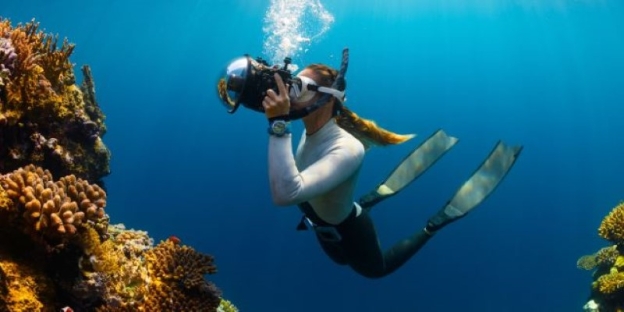
Good locations include Hanauma Bay (Hawaii), Cozumel (Mexico), the Maldives, and the Great Barrier Reef (Australia). Aim for the dry season—typically December to May—for calmer seas and clearer water.
Surfing And Bodyboarding: Where Adrenaline Meets Skill
Surfing and bodyboarding are wave-riding sports available at most major beach destinations. Surf lessons generally cost $50–$100, with board rentals between $10–$30 per day. Beginners often prefer bodyboarding for its easier learning curve.
Great places to try both include Waikiki Beach (Hawaii), Bondi Beach (Australia), Tamarindo (Costa Rica), and Huntington Beach (California). The best waves arrive November through March in many locations, though beginner-friendly beaches work year-round.
Kayaking And Paddleboarding: Fun With A Workout
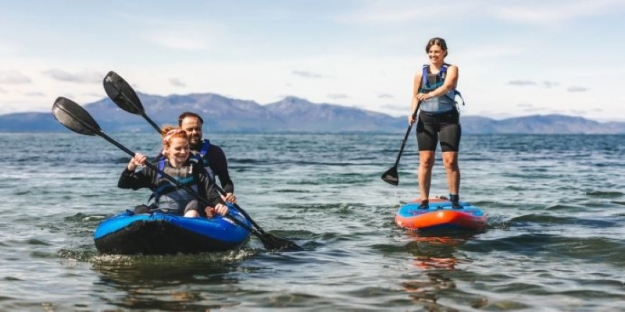
Kayaking and stand-up paddleboarding offer a low-stress way to explore calm waters while staying active. Rentals typically cost $15–$40 per hour. Popular spots include La Jolla Cove (California), Tulum (Mexico), Lake Tahoe (Nevada), and Key West (Florida). The best conditions are from April to October, when water is warmer and winds are mild.
Jet Skiing And Parasailing: Thrills Above And Beyond
Jet skiing and parasailing are fast-paced activities that require minimal instruction and are widely available at beach resorts. Expect to pay $60–$120 for a 30-minute jet ski session and $70–$100 for parasailing.
Top locations include Miami Beach (Florida), Cancun (Mexico), the Gold Coast (Australia), and Phuket (Thailand). Ideal weather falls between May and September when skies are clearer and ocean conditions are safer.
Vacation Beach Games That Bring People Together
You don’t need expensive gear or formal setups to enjoy the beach. Simple games like volleyball, frisbee, or paddleball are easy to organize, social, and a fun way to stay active without much planning.
Volleyball And Beach Soccer
These games work well with both small and large groups, and many public beaches have permanent nets or courts available. Volleyball nets are often free to use, though some resorts charge $5–$15 for access. Beach soccer needs only a ball and open space.
Top beaches for these games include Copacabana (Brazil), Barceloneta Beach (Spain), Venice Beach (California), and Jumeirah Beach (Dubai). The best time to play is spring through early autumn (March to October), when the sand is warm but not scorching.
Frisbee, Spikeball, And Paddleball
These games are low-effort, low-cost, and easy to carry. A decent frisbee or paddleball set costs around $10–$25, while a full Spikeball kit runs about $50. Ideal spots include Santa Monica Beach (California), Bondi Beach (Australia), and South Beach (Florida), where there’s enough space and energy to match the mood. Early mornings or late afternoons during warmer months—especially May to September—are the most comfortable times to play.
Sandcastle Contests

No age limit or skill required—just wet sand, a bucket, and some imagination. Sandcastle building is free, but organized events like the Revere Beach Sand Sculpting Festival (Massachusetts) or Cannon Beach’s Sandcastle Contest (Oregon) draw both amateurs and professionals. Summer is the best time for this activity, particularly June through August when special events are held and conditions are dry.
Relaxing Yet Active Beach Travel Activities
Not every day at the shore has to be about speedboats and competitive games. Some of the most rewarding beach travel activities are the quiet ones—the ones that let you enjoy the sea breeze, stretch your body, and soak in the atmosphere while still keeping you moving.
Morning Yoga Or Tai Chi On The Sand
Gentle movement sessions like yoga or tai chi are often available on or near popular beaches, especially in resort areas. These early-morning classes typically cost between $10 and $20, and some are even free for resort guests. Good locations include Tulum (Mexico), Uluwatu (Bali), and Maui (Hawaii), where sunrise sessions are common. The best time to join is in the dry season, generally between May and October, when mornings are cooler and weather is clear.
Jogging Or Walking Along The Shoreline
Beach jogging or walking is a free and accessible way to stay active while enjoying ocean views. Hard-packed sand near the water makes for easier footing. Great locations for this include Myrtle Beach (South Carolina), Clearwater (Florida), and Santa Monica (California). The best times are early mornings or evenings to avoid direct sun, especially during spring and fall when temperatures are mild.
Collecting Seashells Or Exploring Tidepools
Seashell collecting and tidepool walks offer a quiet way to explore nature. These activities are free and well suited to families or solo travelers. Top spots include Sanibel Island (Florida) for shelling, Cannon Beach (Oregon) for tidepools, and Kalaloch Beach (Washington) for both. Plan your visit around low tide, with the spring and early summer months offering the clearest access and best conditions.
Adventure Beyond The Shoreline
Your beach experience doesn’t have to end where the sand meets the water. Many destinations offer adventures that begin at the shoreline but lead you to entirely new perspectives of the coast.
Boat Tours And Dolphin-Watching
Boat excursions are widely available at beach destinations, ranging from short glass-bottom rides to half-day catamaran cruises. Many tours include dolphin- or whale-watching opportunities, often combined with snorkeling or sunset views. Prices range from $30 to $80 per person depending on duration and add-ons.
Recommended locations include the Big Island (Hawaii), Cabo San Lucas (Mexico), Tenerife (Canary Islands), and the Bahamas. The best season varies by region, but dolphin-watching is generally best between April and October, with winter months being ideal in Hawaii and the Caribbean.
Deep-Sea Fishing Trips
Chartered fishing trips take you several miles offshore where larger catches like tuna, mahi-mahi, and marlin are common. These tours typically cost between $100 and $300 per person for a half-day trip.
Reliable destinations include the Outer Banks (North Carolina), Cabo San Lucas (Mexico), Key West (Florida), and Seychelles. Fishing seasons vary, but spring through early fall (April to September) offers the best success rates in most locations.
Hiking Coastal Trails
Coastal trails give you a land-based way to explore shorelines, often with dramatic views and access to secluded beaches. Entry is usually free or part of a small park fee (around $5–$20).
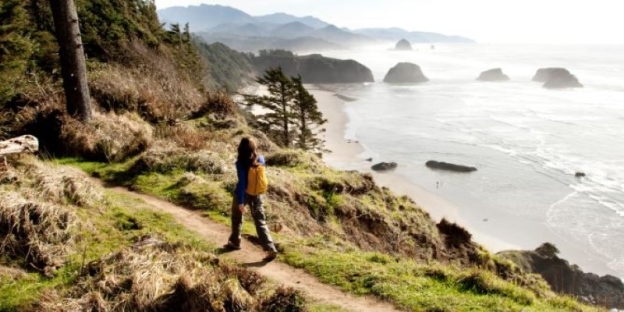
Excellent hikes include the Kalalau Trail (Hawaii), Cinque Terre trails (Italy), the Pacific Coast Trail in California, and Cornwall’s South West Coast Path (UK). The best season for hiking is spring or fall when temperatures are moderate and trails are less crowded—typically March to May and September to October.
Nighttime Fun On The Beach
Just because the sun sets don’t mean the shoreline fun has to stop. Evening hours open the door to a different kind of magic, with activities that bring people together under starlit skies.
Bonfires And Storytelling
At beaches where fires are allowed, bonfires are a simple way to enjoy the evening. You’ll need to bring your own firewood (about $10–$20) and possibly obtain a permit depending on local rules.
Some beaches offer designated fire rings, such as Huntington Beach (California), Ocean Beach (San Diego), and Dockweiler Beach (Los Angeles). The best time for a beach bonfire is during spring and fall evenings when the weather is cooler and crowds are lighter.
Glow-In-The-Dark Games
LED-lit sports equipment adds a fun twist after sunset. Gear like glow-in-the-dark frisbees, volleyballs, and paddleball sets cost around $20–$50 and can be packed in a beach bag. Choose wide, flat beaches with enough space and low foot traffic at night—good options include Myrtle Beach (South Carolina), Virginia Beach, and Jumeirah Beach (Dubai). These games work best in summer when nights are warm and dry.
Stargazing And Night Photography
For quieter nights, beaches far from city lights offer excellent stargazing. You don’t need equipment, just a blanket and a clear sky. For photography, tripod and a camera with manual settings are helpful for long-exposure shots.

Top locations include Assateague Island (Maryland), Kalaloch Beach (Washington), and Cannon Beach (Oregon). The best time to stargaze is during new moon phases or meteor showers, especially from late spring to early fall.
How To Choose The Right Beach Activities For Your Vacation Style?
With so many ways to spend your time by the ocean, it's helpful to consider what kind of traveler you are. The "best" beach travel activities often depend less on location and more on your vacation goals.
For Families
Safety and accessibility usually come first. Families tend to enjoy group-friendly vacation activities, such as volleyball, sandcastle contests, or Frisbee. Paddleboarding and kayaking are also safe options because they are well-suited for beginners and don't require advanced skill levels. Children especially enjoy exploring tidepools or collecting shells, making learning a fun and engaging experience.
For Couples
Romantic experiences often mix relaxation with adventure. Sunset beach walks, tandem kayaking, or even trying out parasailing together create shared memories. Many couples also gravitate toward activities that strike a balance between privacy and fun—such as stargazing after a bonfire or joining a snorkeling tour designed for small groups.
For Solo Travelers
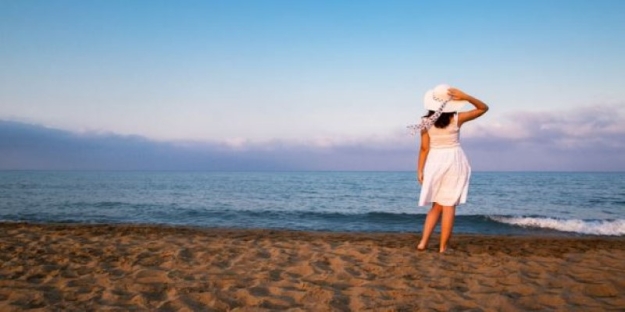
If you're traveling solo, the beach becomes both a personal retreat and a social hub. Yoga sessions, shoreline jogging, and meditation are great ways to unwind alone, while team-based vacation beach games or surf lessons can be opportunities to meet new people. Solo travelers often seek activities that combine self-discovery with meaningful connection.
Safety Tips For Enjoying Water And Beach Games
While beaches are naturally inviting, they come with risks that are easy to forget once you’re caught up in the fun. Being mindful of safety ensures your water sports at beach destinations remain memorable for the right reasons.
Respect Lifeguard Zones And Flags
Pay attention to lifeguard stations and beach flag systems, which indicate water conditions. A red flag typically indicates dangerous currents, while a yellow flag may signify caution. Swimming or surfing outside monitored areas increases the risk, regardless of your level of experience.
Stay Hydrated And Protected From The Sun
Even shaded areas don’t fully protect you from UV exposure. According to CDC, applying broad-spectrum sunscreen, wearing hats, and drinking water regularly keep you safe during long activity sessions.
Use Proper Gear For Water Sports
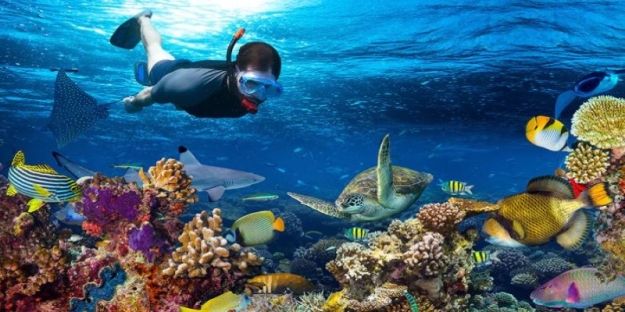
Snorkeling without a vest, surfing without a leash, or kayaking without a life jacket can quickly turn into a risky activity. Rental shops usually provide equipment, but checking its condition before heading out is wise. Especially for beginners, sticking to entry-level gear helps prevent injuries.
Watch The Tide And Weather
High tide can cut off walking paths, while sudden storms may create strong rip currents. Always check local forecasts and tide charts before heading out to ensure a safe experience. Apps and local beach information boards provide real-time updates that can save you from surprises.
Packing Essentials For Active Beach Vacations
The right gear can make your vacation beach games and water sports seamless, while the wrong setup can mean frustration. Think of your beach bag as both a comfort kit and a safety net.
Lightweight Sports Gear
Compact paddleball sets, inflatable SUP boards, or foldable frisbees save space while still giving you hours of fun. Some resorts provide equipment but bringing a few personal items guarantees you’re never without entertainment.
Sun And Shade Essentials
A wide-brimmed hat, polarized sunglasses, and reef-safe sunscreen protect you while maintaining comfort. Portable shade tents or umbrellas also allow you to cool down between activities without having to leave the beach.
Hydration And Snacks
Reusable water bottles with insulation keep drinks cool for hours. Pair these with high-energy snacks, such as fruit, nuts, or granola bars, to refuel between beach activities. Staying energized helps you make the most of your time.
Waterproof And Sandproof Storage
Waterproof dry bags or sand-resistant backpacks keep your essentials safe and dry. Stashing electronics, extra clothes, and small first-aid kits in these bags ensures your fun isn't interrupted by preventable mishaps.
Packing smart means you spend more time enjoying the ocean and less time worrying about what you left behind.
Bringing It All Together — Making Your Vacation Memorable
When you picture the perfect beach trip, it’s rarely just about lying on a towel. What makes a vacation unforgettable are the moments that mix relaxation, laughter, and discovery. Choosing the right balance of beach travel activities, vacation beach games, and thrilling water sports at beach destinations ensures that everyone—whether family, couple, or solo adventurer—gets exactly what they’re looking for.
A morning yoga session may set the tone for calm, while an afternoon volleyball match sparks energy. Maybe the highlight is exploring underwater reefs, or maybe it’s gathering around a bonfire after dark. The key is variety—allowing each day to hold something new without feeling forced.
Research suggests that experiences, rather than possessions, are more likely to lead to long-term happiness. A recent Harvard Health article emphasized that shared activities and social interactions can create stronger bonds and more vivid memories than typical routines. That’s why your next beach trip can be much more than sand and sunshine—it can be a collection of moments that stay with you long after the tide has gone out.
Making The Most Of Your Next Beach Getaway
Every shoreline has its own rhythm, and the activities you choose shape how you experience it. Whether you’re paddling across calm waters, teaming up in vacation beach games, or simply walking at dusk to collect seashells, the ocean always offers more than just a view.
By blending movement, social connection, and relaxation, you transform your trip into something far more rewarding. Pack wisely, stay safe, and follow your instincts when picking what feels right. When you do, your beach vacation won’t just be about where you went—it’ll be about everything you did while the waves rolled in beside you.
Was this helpful? Share your thoughts
- Learned practical methods
- Solved my questions
- Inspired new ideas
-
![Snorkelling In Bali For Beginners: Best Spots & Tours]() Snorkelling In Bali For Beginners: Best Spots & Tours
Snorkelling In Bali For Beginners: Best Spots & Tours -
Diving into Bali's underwater world offers an accessible adventure for those new to snorkelling, where calm bays and colourful reefs create a welcoming environment. This guide covers everything from ideal spots to practical advice, ensuring beginners feel confident and prepared. With its affordable options and diverse marine life, Bali stands out as a top destination for first-timers seeking memorable experiences without overwhelming challenges.
Explore More
-
![Top 20 Ways To Make Long Flights Comfortable]() Top 20 Ways To Make Long Flights Comfortable
Top 20 Ways To Make Long Flights Comfortable -
Why does a 12-hour flight leave one person shattered, while another remains strangely calm? The difference is preparation. Here's a comprehensive, practical playbook for achieving long flight comfort—so you don't just survive long flights, but make them work for you.
Explore More





